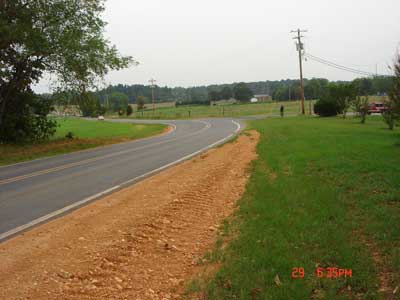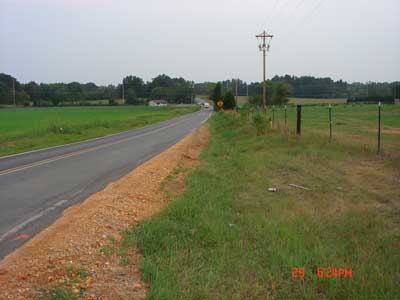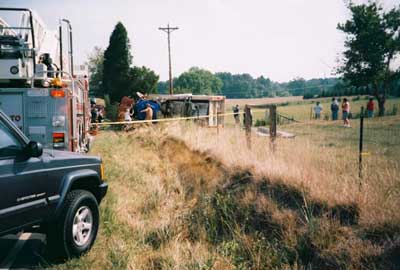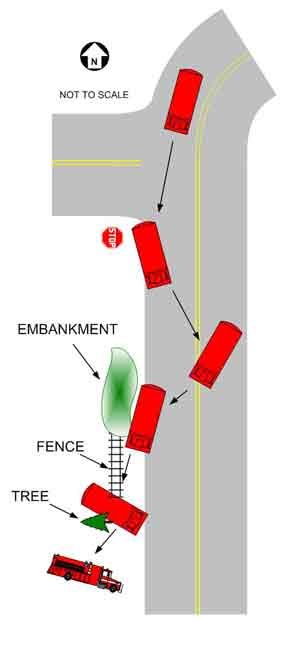Volunteer Fire Fighter Responding to an Automatic Alarm Dies When Engine Collides With an Embankment and Tree then Overturns - North Carolina
 Death in the Line of Duty…A summary of a NIOSH fire fighter fatality investigation
Death in the Line of Duty…A summary of a NIOSH fire fighter fatality investigation
F2007-30 Date Released: September 22, 2009
SUMMARY
On August 11, 2007, a 43-year-old male volunteer fire fighter died while he was responding to an automatic alarm driving an engine. Less than half-mile from the station, the victim rounded a curve and went off the right side of the road onto the shoulder, swerving to miss a vehicle that crossed over the centerline from the opposite direction. The victim steered the engine back onto the road and crossed the centerline. While attempting to control the engine the victim overcorrected and again ran off the right side of the road. The engine collided with a fenced embankment, skidded side ways, struck a tree, and overturned. The engine came to rest lying on the driver’s side of the road.
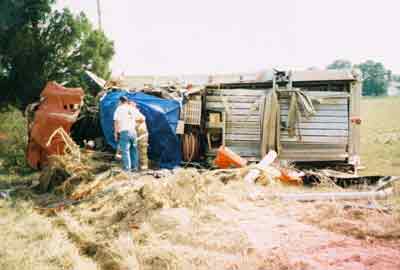 |
Front Cover Photo
|
Fire fighters responding in a ladder truck from the victim’s department found the victim entrapped in the cab of the engine, within a minute of the incident. The victim was found to be unresponsive and was pronounced dead at the scene by Emergency Medical Services (EMS) personnel. Key contributing factors identified in this investigation include: driver training, unsafe speed for roadway conditions, the potential of the driver’s inexperience with driving a fire department vehicle under emergency conditions, sharp shoulder drop-off, and the unsafe driving by a civilian driver.
NIOSH investigators concluded that to minimize the risk of similar incidents fire departments should:
- enhance their driver/operator training programs to include road and apparatus hazard recognition and emphasize the need for new drivers to understand and recognize the potential hazards which may occur while operating a fire department vehicle during emergency operations
- consider requiring that emergency vehicle operators/drivers receive driver training from a State or other nationally recognized training program, in addition to specific departmental driver training
- establish, implement, and enforce standard operating procedures (SOPs) that incorporate guidelines for safe and prudent driver/operator training and include detailed curriculum for the classroom and hands-on training that is specific to the roadways within their jurisdiction and for each apparatus
- attempt to establish working relationships with roadway authorities to identify and correct roadway hazards (e.g., drop-offs, potholes and other road deformities) on the roads and highways within their jurisdiction
- consider working with municipalities to impose a false alarm ordinance that targets facilities that fail to adequately maintain their alarm systems
INTRODUCTION
On August 11, 2007, a 43-year-old male volunteer fire fighter died while responding in an engine to an automatic alarm. The victim who was driving the engine died in a single-vehicle crash. On August 13, 2007, the National Institute for Occupational Safety and Health (NIOSH) was notified of this incident by the U. S. Fire Administration (USFA). On August 29, 2007, an investigation of this incident was conducted by a Safety and Occupational Health Specialist from NIOSH. Meetings and interviews were conducted with the Chief, Assistant Chief, Captain, and Captain/Training Officer from the combination fire department. In addition, the County’s Deputy Fire Marshal and a member of the County Fire Chief’s Association attended the opening conference. The incident site was visited. Copies of the department’s Standard Operating Procedures (SOPs), witness statements, vehicle maintenance records, medical examiner’s report and the State Highway Patrol report were reviewed. Follow-up communication by NIOSH with the County’s Deputy Fire Marshal occurred on September 24, October 22, and October 25, 2007. A telephone call with the Assistant Chief was conducted on May 16, 2008.
FIRE DEPARTMENT
The combination fire department involved in this incident serves a population of 15,000 in a geographical area of 30 square miles and was comprised of 45 volunteer and 13 career fire fighters. The department has two fire stations. The fire department serves an area that is mostly rural, but is one of the fastest growing areas in North Carolina. The department had four engines, one ladder truck, one tanker truck, and one brush truck. Repair and service of all motorized apparatus was provided by an area garage. As part of its administrative policies, the fire department has standard operating procedures (SOPs) for self contained breathing apparatus (SCBA) use, full bunker gear, PASS devices, communications equipment, emergency vehicle operations, and incident command. The department had not experienced any other deaths or vehicular related incidents prior to this incident.
TRAINING and EXPERIENCE
The department requires that a fire fighter be 18-years old and complete a 90-day probationary period. Prior to a fire fighter participating on a structure fire, they are required to attend live-fire training that meets the training requirements of NFPA 1403.1 According to a North Carolina County Deputy Fire Marshal, the state of North Carolina has no minimum state training requirements for volunteer fire fighters. To remain a fire fighter in good standing, the department requires a fire fighter have 36 hours of training and attend 3-hours of haz-mat awareness level training each year. Additionally, the department requires a fire fighter respond to ten percent of the calls each quarter and assist with a minimum of one fire department function per month.
The victim had been a volunteer member of the combination department for approximately 18 months. He joined the department in April 2006 and was named the “Rookie Fire Fighter” of that year. Since becoming a member of the department, the victim had completed a total of 68 hours of various training. The victim completed Fire Fighter I in April 2007. The victim became a qualified driver for all of the department’s apparatus with the exception of the ladder truck on July 10, 2007. He held a Regular Class C state driver’s license. During 2007, the victim had attended nine hours of department driver training and completed eleven hours of hands-on driving. The department requires that drivers complete a minimum of 4 hours and up to six hours of basic driver training and a minimum of ten hours of hands-on-driving. The hands-on-driving consists of demonstrating the ability to safely operate each vehicle and deal with situations that the driver is likely to encounter during normal and emergency operations. The department requires that drivers attend three hours of refresher driver training every six months, for a total of six hours per year. The department has rules addressing emergency driving that impose suspensions and re-certification requirements for complaints made against individual department drivers. The department requires a driving candidate to have a qualified emergency vehicle operator ride-along with a department qualified emergency vehicle operator on their first ten emergency driving responses. Upon ten successful emergency responses, a driver is considered eligible to drive a fire apparatus solo to emergency calls. The victim completed ten successful emergency responses with a qualified emergency vehicle operator and drove to his first solo call on July 29, 2007.
The victim’s full time occupational trade was within the financial services industry.
EQUIPMENT
The vehicle involved in this incident was a 1997 fire engine with an automatic transmission, a full 1,000 gallon baffled water tank, and an air-braking system with a secondary engine braking system (Cover Photo). The engine was purchased new by the department. The engine’s gross vehicle weight rating was 42,500 lbs and had a commercial chassis. The engine had two axles with 6 wheels (two in the front and four in the rear). The engine was equipped with a shoulder and lap belt (3-point) occupant restraint system. Six weeks prior to the incident, the engine received all new tires. Although not required by the State of North Carolina, the engine passed a safety inspection that was conducted at an area garage in April 2007.
CLOTHING/GEAR
When the incident occurred the victim was wearing civilian type clothing and tennis shoes. His bunker gear was stored on board.
WEATHER/ROAD CONDITIONS
The incident occurred on a clear day with no precipitation present in the area. The rural road surface was comprised of asphalt pavement. On the south side of the roadway, where the incident occurred, there was wire fence and a few trees. The shoulder of the road where the incident occurred was a combination of dirt and grass. According to the fire department, several of the shoulders preceding and beyond the curve where the incident occurred had an approximate 9-12 inch drop off from the pavement to the shoulder. The Chief stated to NIOSH that he verbally made his members aware of the road problem and that he had contacted the state road department approximately 6 times over a six month period to convey his concerns over the road shoulder drop-offs. According to the department, several days following the incident, the department of transportation filled the shoulder drop offs with dirt. When NIOSH conducted the site visit, the shoulder fill dirt was visible in several areas. The speed limit on the road where the incident occurred is 45 miles-per-hour (mph); the curve that the victim traveled through prior to the incident has a posted caution speed of 35 mph.
INVESTIGATION
On August 11, 2007, at approximately 1616 hours, the combination department was dispatched to an automatic fire alarm at an elementary school that was under construction. The department reported that prior to this call they had responded twice within 48 hours to the same automatic fire alarm and that the victim had responded to one of the calls in his privately owned vehicle (POV) on August 9, 2007. At approximately 1622 hours, an engine with a volunteer fire fighter driving (the victim) responded and less than a minute later, a ladder truck with two fire fighters followed.
The victim was traveling south on a state road, with lights and siren activated. After traveling less than a half-mile from the station, he negotiated a curve with a posted caution speed of 35 mph (Photo 1). After completing the curve, the engine’s right wheels ran off the road, the victim steered the engine back onto the road, then the engine crossed over the center line. The victim overcorrected and ran off the right (south) side of the road again. The engine struck a fenced embankment, skidded side ways, struck an approximately 15-inch diameter cedar tree and overturned (Diagram and Photo 2). The engine came to rest sitting driver side down off of the roadway (Photo 3). The victim was wearing his lap and shoulder seat belt occupant restraint system.
At approximately 1624 hours, the ladder truck that had been following the engine came upon a large amount of dust and saw the engine lying off the right (south) side of the road. The fire fighter riding as a passenger in the ladder truck radioed the dispatch center to report the incident. Both the driver and the fire fighter from the ladder truck got out and ran to check on the fire fighter operating the engine. They found the victim entrapped in the cab of the engine. The windshield of the engine was missing and one of the victim’s arms was visible. The driver of the ladder truck was unable to find a radial pulse present on the victim. According to the fire fighters from the ladder truck, a civilian witness stated that a vehicle ran into the engine’s south bound lane and that the victim swerved to miss hitting it.
At 1625 hours, the state highway patrol and emergency medical services (EMS) were dispatched and they arrived at the scene by 1630 hours. At 1635 hours, EMS pronounced the victim dead on the scene. The state highway patrol report estimated that the tanker truck was traveling approximately 45 mph at the time of the incident. The automatic fire alarm that the victim was responding to was a false alarm.
CONTRIBUTING FACTORS
Occupational injuries and fatalities are often the result of one or more contributing factors or key events in a larger sequence of events that ultimately result in the injury or fatality. NIOSH investigators identified the following items as key contributing factors in this incident that ultimately led to the fatality:
- Driver training.
- Driving at an unsafe speed for the conditions on the rural roadway.
- Potential of the driver’s inexperience with driving a fire department vehicle under emergency conditions.
- Sharp drop-off on shoulder of the roadway.
- Unsafe driving by a civilian driver on the roadway coming from the opposite direction.
CAUSE OF DEATH
The medical examiner listed the cause of death as blunt head and chest trauma due to a motor vehicle accident.
RECOMMENDATIONS
Recommendation #1: Fire departments should enhance their driver/operator training programs to include road and apparatus hazard recognition and emphasize the need for new drivers to understand and recognize the potential hazards which may occur while operating a fire department vehicle during emergency operations.
Discussion: When a department conducts initial driving and refresher driver training, it is imperative that fire fighters that are deemed as department drivers understand all the potential hazards that may be present while driving a fire apparatus. According to the “Safe Operation of Fire Tankers,2” one of the most common causes of serious fire department crashes is overcorrection by the driver when the vehicle’s tires leave the roadway. NFPA 1500 Section 6.2.4: Drivers/Operators of Fire Department Apparatus states that “Drivers of fire apparatus shall be directly responsible for the safe and prudent operation of fire department vehicles.” 3 The posted speed limit on the road where the incident occurred was 45 miles-per-hour (mph), and the curve that the victim traveled through prior to the incident had a posted caution speed of 35 mph. The North Carolina Highway Patrol uniform traffic accident report estimated the speed of the engine at 45 mph at the time of the incident. According to the USFA publication “Safe Operation of Fire Tankers,” 2 the suggested speed on these caution signs are intended for passenger cars under ideal conditions. Drivers of all large fire department vehicles must consider these “suggested” speeds as the absolute maximum for their vehicles. After completing the curve, the engine’s right wheels ran off the right (south) side of the road, the victim steered the engine back onto the road and crossed over the center line, then overcorrected and again ran off the right side of the road.
According to the U.S. Fire Administration (USFA), when a fire apparatus strikes road bumps, potholes, and other deformities while traveling at an unsafe speed, it may be difficult for the driver to control.2 “The sudden jar of a road deformity may throw the vehicle to one side or the other.”2 If the vehicle bounces as a result of the road deformity, it may be difficult to steer or brake, causing the vehicle to go into a slide.2 Avoiding conditions that lead to skidding is as important as knowing how to correct skids once they occur.
The most common causes of skids include
- Driving too fast for road conditions
- Failing to properly appreciate weight shifts of heavy apparatus
- Failing to anticipate obstacles (these range from other civilian vehicles to animals)
- Improper use of auxiliary braking devices
- Improper maintenance of tire air pressure and adequate tread depth. 4
According to the Safe Operation of Fire Tankers,2 a fire apparatus driver often gets into trouble when attempting to return the vehicle to the paved surface by quickly turning the steering wheel toward the left while still traveling and maintaining speed. Often the result of this action is the apparatus lurching severely towards the left when the right side wheels jump back onto the paved surface. This may cause the tanker to travel into oncoming lanes of traffic, travel completely over to the opposite side of the roadway, or to simply over-turn. If the right-side wheels get off the edge of the road, it is important that the driver not try to bring the apparatus back onto the road surface while attempting to maintain speed. According to Safe Operation of Fire Tankers,2 the driver should slow the apparatus to an appropriate speed to remount the paved surface before attempting to bring the wheels back onto the road surface.
A department’s driver training program should include road and apparatus hazard recognition and emphasize the need for new drivers to understand and recognize the potential hazards which may occur while operating a fire department vehicle during emergency operations. The victim had completed the department’s emergency driver course, but the victim had a limited amount of real experience driving a fire apparatus. In reality, there is no way of avoiding putting new drivers behind the wheel of a fire apparatus at some point in time. Everyone must have a starting point in his or her career. Ensuring that drivers complete a comprehensive training program prior to being allowed to operate the vehicle under response conditions can minimize the dangers associated with limited experience. The driving training program should emphasize the fact that even though the drivers may complete the program and be certified to drive under emergency response conditions, they still need to be extra cautious and have real emergency driving experience to back up all of their training.2
Recommendation #2: Fire departments should consider requiring that emergency vehicle operators/drivers receive driver training from a State or other nationally recognized training program, in addition to specific departmental driver training.
Discussion: Establishing an effective fire apparatus driver training program is not a quick and simple process. There are multiple components of a properly designed driver training program, including classroom (theoretical) and practical (hands-on) training sessions. Fire departments should consider requiring their emergency vehicle operators/drivers to receive driver training from a State or other nationally recognized training program, in addition to specific departmental driver training.
Requiring that emergency vehicle operator/drivers successfully complete an accredited emergency vehicle driver training program in addition to specific departmental driver training provides a consistent foundation for driving a fire apparatus in emergency and non-emergency situations. The accredited emergency driving program would provide consistent instructor qualifications, classroom (theoretical) instruction (i.e., applicable laws and liabilities, vehicle dynamics, emergency and non-emergency driving procedures, crash and injury prevention measures and vehicle and apparatus care procedures), practical (hands-on) driving with an evaluation, and written examination.2
The State of North Carolina where this incident occurred has a voluntary “Emergency Vehicle Driver Certification”5 program, that consists of entrance requirements, program requirements, student evaluations, and practical examination. The North Carolina driver certification course requires 134 hours of classes (20 hours of Emergency Vehicle Driver) and an additional 60 hours for aerial operations. The department in this incident requires drivers to complete a minimum four hours of basic driver training and ten hours of hands-on-driving.
The fire department involved in this incident is in the future going to require that prior to a fire fighter being eligible to be an emergency driver/operator for the department, the fire fighter must complete the North Carolina “Emergency Vehicle Driver Certification course.5” After receiving the North Carolina Driver Certification, the department in this incident will require that an eligible driver participate in their specific departmental driving training program.
Recommendation #3: Fire departments should establish, implement, and enforce standard operating procedures (SOPs) that incorporate guidelines for safe and prudent driver/operator training and include detailed curriculum for the classroom and hands-on training that is specific to the roadways within their jurisdiction and for each apparatus.
Discussion: NFPA 1500 § 6.2.7.1 states: “Procedures for all responses shall emphasize that the safe arrival of fire apparatus to the incident scene is the first priority.”3 NFPA 1500 § 6.2.7 states: “That fire departments shall develop standard operating procedures for safely driving fire apparatus during non-emergency travel and emergency response and shall include specific criteria for vehicle speed, crossing intersections, traversing railroad grade crossings, the use of emergency warning devices, and backing of fire apparatus.” 3
The department in this incident has rules addressing emergency driving that impose suspensions and re-certification requirements for complaints made against individual department drivers, however, the SOPs should be expanded to incorporate specific references to driver/operator safety procedures. The SOPs should include guidance on driving department and personal vehicles during emergency response, as well as operating fire apparatus during non-emergency travel.6 The SOPs should include, but not be limited to, the principles of skid avoidance, load factors, general steering reactions, driving on rural type roads, and roadway caution and speed limits.
In implementing these procedures it is imperative that they are fully endorsed and strictly adhered to by the entire department including all command officers from the chief level down. Adoption of SOPs in this manner significantly promotes a positive safety culture within any work organization. Before any safety program gets underway, it must receive full support and commitment from top management and administration.7
Additionally, the department has rules designating the number of hours required for the classroom training and the hands-on training, however, the SOPs should also include curriculum details, the covered subjects and the amount of designated time allotted for each topic and the required apparatus maneuvers for each department emergency vehicle. The SOPs must incorporate detailed curriculum for the classroom and hands-on training specific to the roadways within the department’s jurisdiction and for each apparatus. In providing detailed SOPs for the curriculum, each of the driver/operators are able to know what is expected of them during the classroom instruction and activities for performing the hands-on training.8, 9 The SOPs for the curriculum and hands-on driving will also assist each designated instructor(s) providing the training with the knoledge of what subjects or issues need to be covered. The curriculum SOPs will also help ensure that the training maintains the necessary consistency for each driver/operator of the department. The SOPs for the hands-on portion of the training will also assist and ensure the coverage of the department’s specific roadway issues within their jurisdiction and with each of their apparatus.
Recommendation #4: Fire departments should attempt to establish working relationships with roadway authorities to identify and correct roadway hazards (e.g., drop-offs, potholes and other road deformities) on the roads and highways within their jurisdiction.
Discussion: Fire departments should attempt to establish working relationships with roadway authorities to identify and correct roadway hazards (e.g., drop-offs, potholes and other road deformities) on the roads and highways within their jurisdiction. This could include established procedures for fire department officials to directly contact department of transportation or the division of highways/roads department to report roadway hazards. Additionally, this process could provide a way for official’s to report unsafe road conditions and allow feedback mechanisms so the fire department is made aware of the plans and timetables for the roadway repairs. All fire department-reported roadway safety hazards and any roadway officials responses should be done in writing. During this investigation, the Chief stated to NIOSH that he verbally made his members aware of the road problem and that he had contacted the state road department approximately 6 times over a six month period to convey his concerns over the road shoulder drop-offs.
Recommendation #5: Fire departments should consider working with municipalities to impose a false alarm ordinance that targets facilities that fail to adequately maintain their alarm systems.
Discussion: According to a report “False Alarm Activity in the U.S.- 2006,” published by the NFPA in 2006, U.S. fire departments responded to 2,119,500 false alarms.10 This means that one out of every ten calls responded to by a fire department were false alarms. Unintentional false calls (e.g., tripping an interior device unintentionally) accounted for 850,000 or 40% of all false alarms. According to the NFPA, unintentional calls increased every year except for 1990, 1997 and 2002 for an overall increase of 206% from 278,000 in 1988 to 850,000 in 2006.10
In this incident, prior to the fire call on August 11, 2007, the department reported that they had responded twice before to the same automatic fire alarm within 48 hours. The Fire Chief reported that he made contact with the site superintendent for the new facility that was under construction and made the request that the automatic alarm be kept in test mode when construction activities were commencing because the sanding of concrete was causing the automatic fire alarms to falsely activate. The fire chief asked them to switch to normal mode when no construction activities were taking place.
On-going false alarms and failure of facilities to properly maintain their fire alarm systems can be handled through either the issuance of citations, fines, or court actions against the facilities.11 Many municipal or county jurisdictions have implemented false alarm ordinances to “fine” facilities failing to adequately maintain their alarm systems and to recoup costs involving multiple fire department responses.12 Automatic fire alarms are installed in occupancies to promptly detect the presence of fire, alert building occupants in a timely manner to evacuate the premises, initiate protective devices and notify the fire department to respond. “Fire department responses to occupancies during fire alarm activations involve multiple apparatus with numerous personnel aboard. Unnecessary responses due to false alarms needlessly endanger fire department personnel and the general public. Measures taken to reduce or eliminate false alarms are essential to accomplish the fire department’s mission to “Save Lives and Conserve Property.” 11
REFERENCES
- NFPA [2007]. NFPA 1403, Standard on Live Fire Training Evolutions. Quincy, MA: National Fire Protection Association.
- USFA/FEMA [2003]. Safe operation of fire tankers. Emmitsburg, MD: U.S. Fire Administration.
- NFPA [2008]. NFPA 1500, Standard on fire department occupational safety and health programs. Quincy, MA: National Fire Protection Association.
- IFSTA [2001]. Pumping apparatus driver/operator handbook. Stillwater, OK: International Fire Service Training Association.
- North Carolina Fire & Rescue Commission. North Carolina Emergency Vehicle Driver Certificationexternal icon. North Carolina Department of Insurance, Office of State Fire Marshal. Raleigh, North Carolina. http://www.ncdoi.com/OSFM/Fire_Rescue_Commission/Default.aspx?field1=Certification_and_Training_-_NC_Emergency_Vehicle_Driver_Certification&user=Certification_and_Training. Date accessed: June 2, 2009. (Link Updated 1/8/2013)
- Cook, Jr. [1998]. Standard operating procedures and guidelines. Saddle Brook, NJ: Penn Well.
- National Safety Council [1997]. Accident Prevention Manual, Loss Control Programs. Itasca, Illinois.
- NFPA [2007]. NFPA 1002 Standard for fire apparatus driver/operator professional qualifications. Quincy, MA: National Fire Protection Association.
- NFPA [2007]. NFPA 1451 Standard for a fire service vehicle operations training program. Quincy, MA: National Fire Protection Association.
- Karter, Jr.[2008]. False Alarm Activity in the U.S.-2006. Quincy, MA: National Fire Protection Association.
- Brown M [2008]. Response to ‘Nuisance Fire Alarm Activations, Can firefighters help eliminate false alarms? Firehouse.com, May 12, 2008.
- The City of Matthews North Carolina [2008]. Chapter 98: False Alarm Ordinancepdf iconexternal icon. http://matthewsnc.gov/portals/0/matthewschapter98.pdf. Date accessed: June 2, 2009. (Link Updated 1/17/2013)
INVESTIGATOR INFORMATION
This incident was investigated by Nancy T. Romano, Safety and Occupational Health Specialist, NIOSH, Division of Safety Research, Surveillance and Field Investigation Branch, Fire Fighter Fatality Investigation and Prevention Program. An expert technical review was conducted by Kevin Roche, Assistant Fire Marshal, Phoenix Fire Department.
PHOTOS AND DIAGRAMS
|
The National Institute for Occupational Safety and Health (NIOSH), an institute within the Centers for Disease Control and Prevention (CDC), is the federal agency responsible for conducting research and making recommendations for the prevention of work-related injury and illness. In fiscal year 1998, the Congress appropriated funds to NIOSH to conduct a fire fighter initiative. NIOSH initiated the Fire Fighter Fatality Investigation and Prevention Program to examine deaths of fire fighters in the line of duty so that fire departments, fire fighters, fire service organizations, safety experts and researchers could learn from these incidents. The primary goal of these investigations is for NIOSH to make recommendations to prevent similar occurrences. These NIOSH investigations are intended to reduce or prevent future fire fighter deaths and are completely separate from the rulemaking, enforcement and inspection activities of any other federal or state agency. Under its program, NIOSH investigators interview persons with knowledge of the incident and review available records to develop a description of the conditions and circumstances leading to the deaths in order to provide a context for the agency’s recommendations. The NIOSH summary of these conditions and circumstances in its reports is not intended as a legal statement of facts. This summary, as well as the conclusions and recommendations made by NIOSH, should not be used for the purpose of litigation or the adjudication of any claim. For further information, visit the program website at www.cdc.gov/niosh/fire or call toll free 1-800-CDC-INFO (1-800-232-4636).
|
This page was last updated on 08/27/09.

